University Report: Economic Condition of Bangladesh Analysis
VerifiedAdded on 2022/09/05
|23
|7472
|20
Report
AI Summary
This report provides a detailed analysis of the economic condition of Bangladesh. It begins with a letter of transmittal and an acknowledgement, followed by an executive summary outlining the country's economic performance and its ranking according to the 2022 Index score. The introduction highlights Bangladesh's impressive economic growth, poverty reduction, and transformation from a developing nation. The report then covers the country's background, including its history, population, languages, religion, and geography. It delves into the political structure, including the role of the President and Prime Minister. The core of the report focuses on the economy, discussing free market principles, GDP growth, key sectors like agriculture and manufacturing, and the importance of ICT and telecommunications. The report mentions the significance of the textile industry and the country's banking sector. It also references UNCTAD data and various economic indicators. The report analyzes the country's economic performance and highlights the challenges and prospects for future growth.
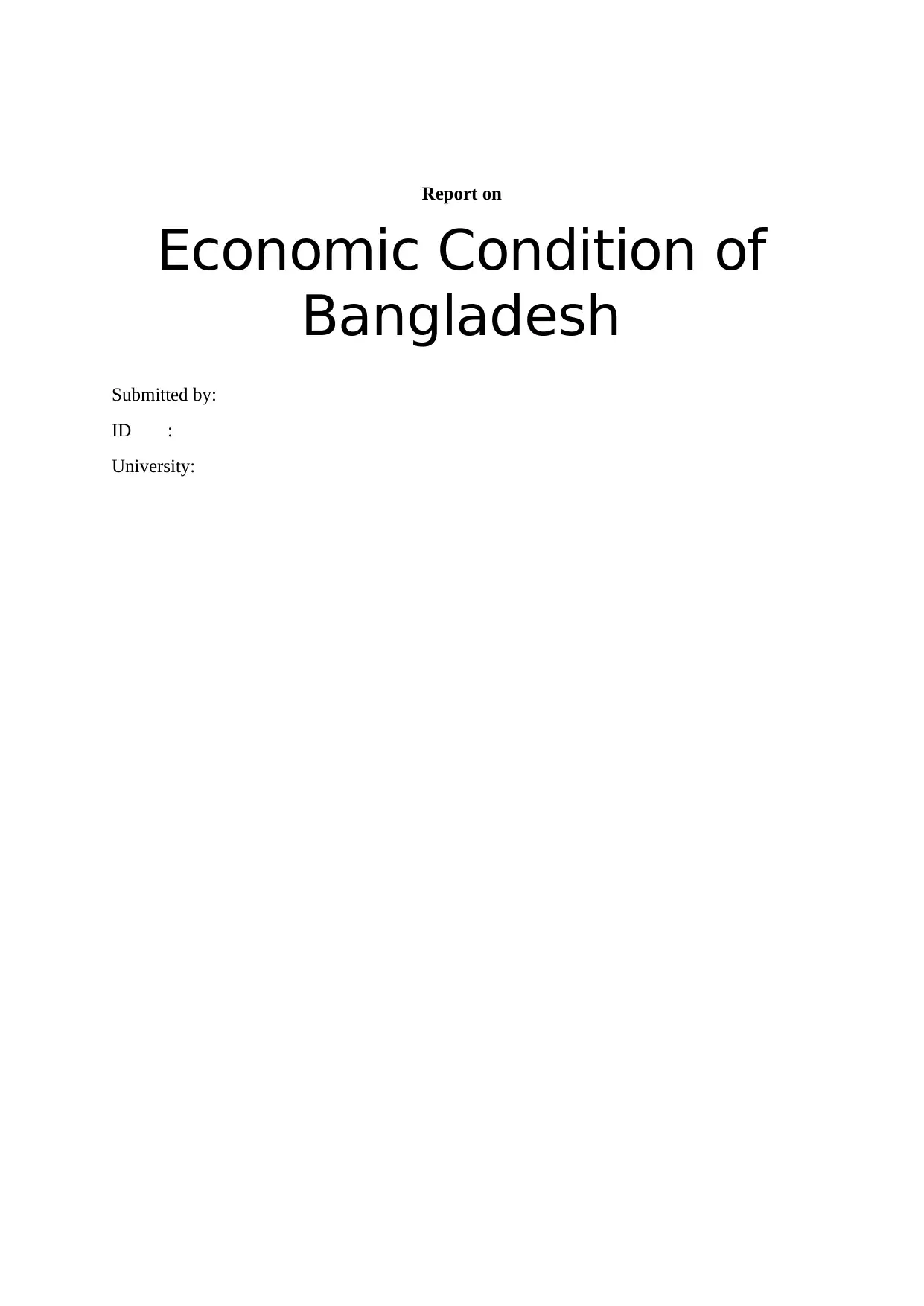
Report on
Economic Condition of
Bangladesh
Submitted by:
ID :
University:
Economic Condition of
Bangladesh
Submitted by:
ID :
University:
Paraphrase This Document
Need a fresh take? Get an instant paraphrase of this document with our AI Paraphraser
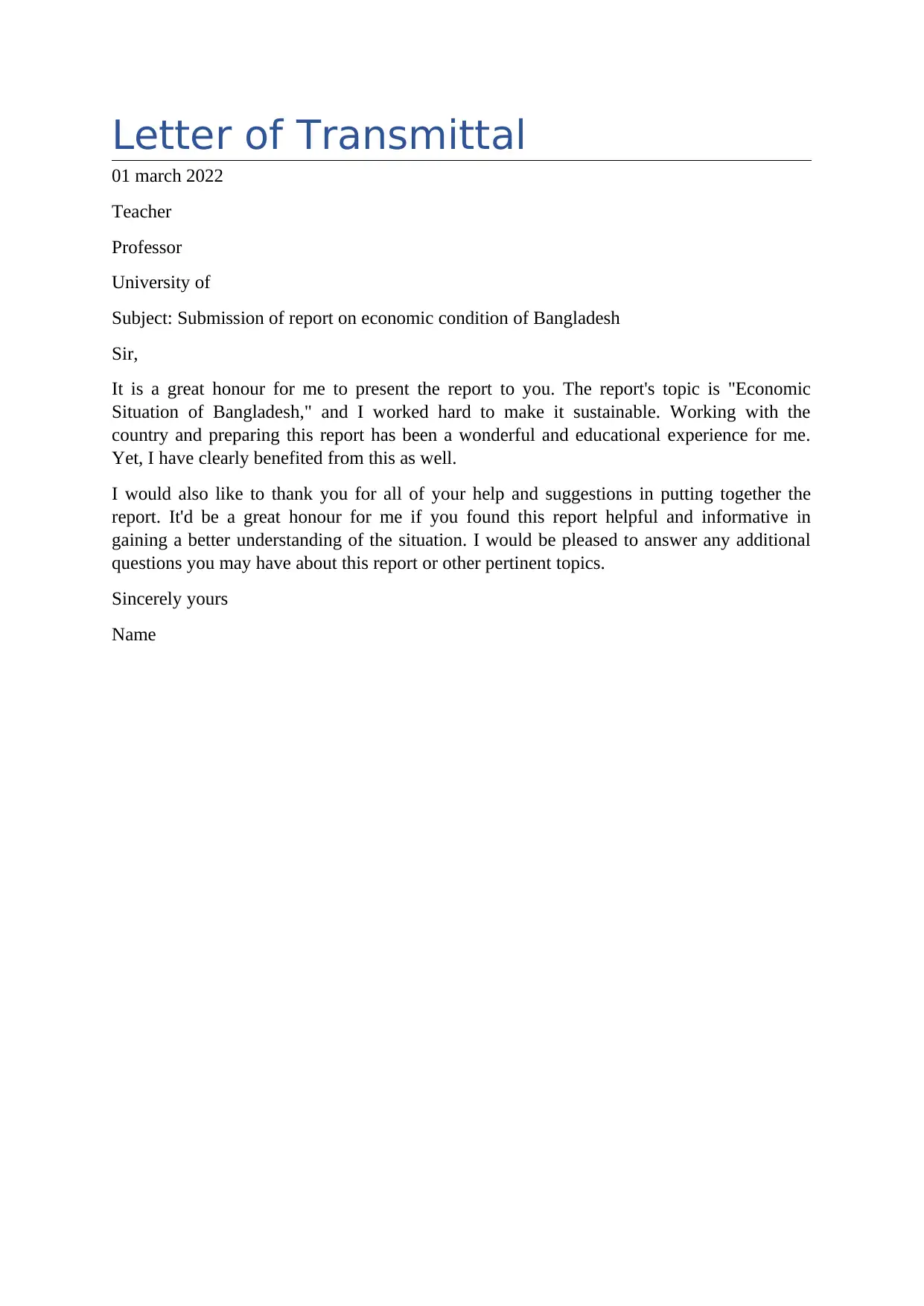
Letter of Transmittal
01 march 2022
Teacher
Professor
University of
Subject: Submission of report on economic condition of Bangladesh
Sir,
It is a great honour for me to present the report to you. The report's topic is "Economic
Situation of Bangladesh," and I worked hard to make it sustainable. Working with the
country and preparing this report has been a wonderful and educational experience for me.
Yet, I have clearly benefited from this as well.
I would also like to thank you for all of your help and suggestions in putting together the
report. It'd be a great honour for me if you found this report helpful and informative in
gaining a better understanding of the situation. I would be pleased to answer any additional
questions you may have about this report or other pertinent topics.
Sincerely yours
Name
01 march 2022
Teacher
Professor
University of
Subject: Submission of report on economic condition of Bangladesh
Sir,
It is a great honour for me to present the report to you. The report's topic is "Economic
Situation of Bangladesh," and I worked hard to make it sustainable. Working with the
country and preparing this report has been a wonderful and educational experience for me.
Yet, I have clearly benefited from this as well.
I would also like to thank you for all of your help and suggestions in putting together the
report. It'd be a great honour for me if you found this report helpful and informative in
gaining a better understanding of the situation. I would be pleased to answer any additional
questions you may have about this report or other pertinent topics.
Sincerely yours
Name
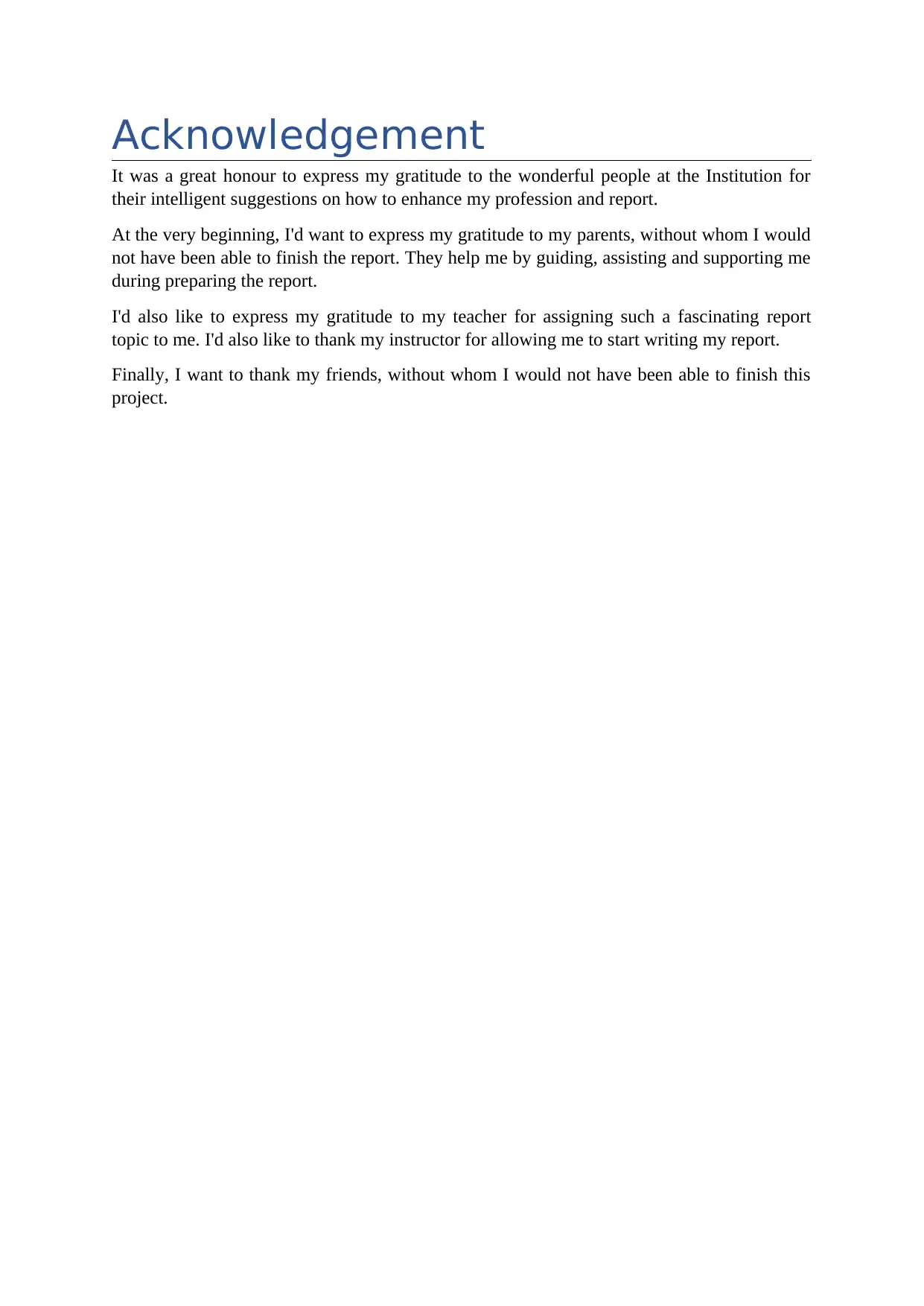
Acknowledgement
It was a great honour to express my gratitude to the wonderful people at the Institution for
their intelligent suggestions on how to enhance my profession and report.
At the very beginning, I'd want to express my gratitude to my parents, without whom I would
not have been able to finish the report. They help me by guiding, assisting and supporting me
during preparing the report.
I'd also like to express my gratitude to my teacher for assigning such a fascinating report
topic to me. I'd also like to thank my instructor for allowing me to start writing my report.
Finally, I want to thank my friends, without whom I would not have been able to finish this
project.
It was a great honour to express my gratitude to the wonderful people at the Institution for
their intelligent suggestions on how to enhance my profession and report.
At the very beginning, I'd want to express my gratitude to my parents, without whom I would
not have been able to finish the report. They help me by guiding, assisting and supporting me
during preparing the report.
I'd also like to express my gratitude to my teacher for assigning such a fascinating report
topic to me. I'd also like to thank my instructor for allowing me to start writing my report.
Finally, I want to thank my friends, without whom I would not have been able to finish this
project.
⊘ This is a preview!⊘
Do you want full access?
Subscribe today to unlock all pages.

Trusted by 1+ million students worldwide
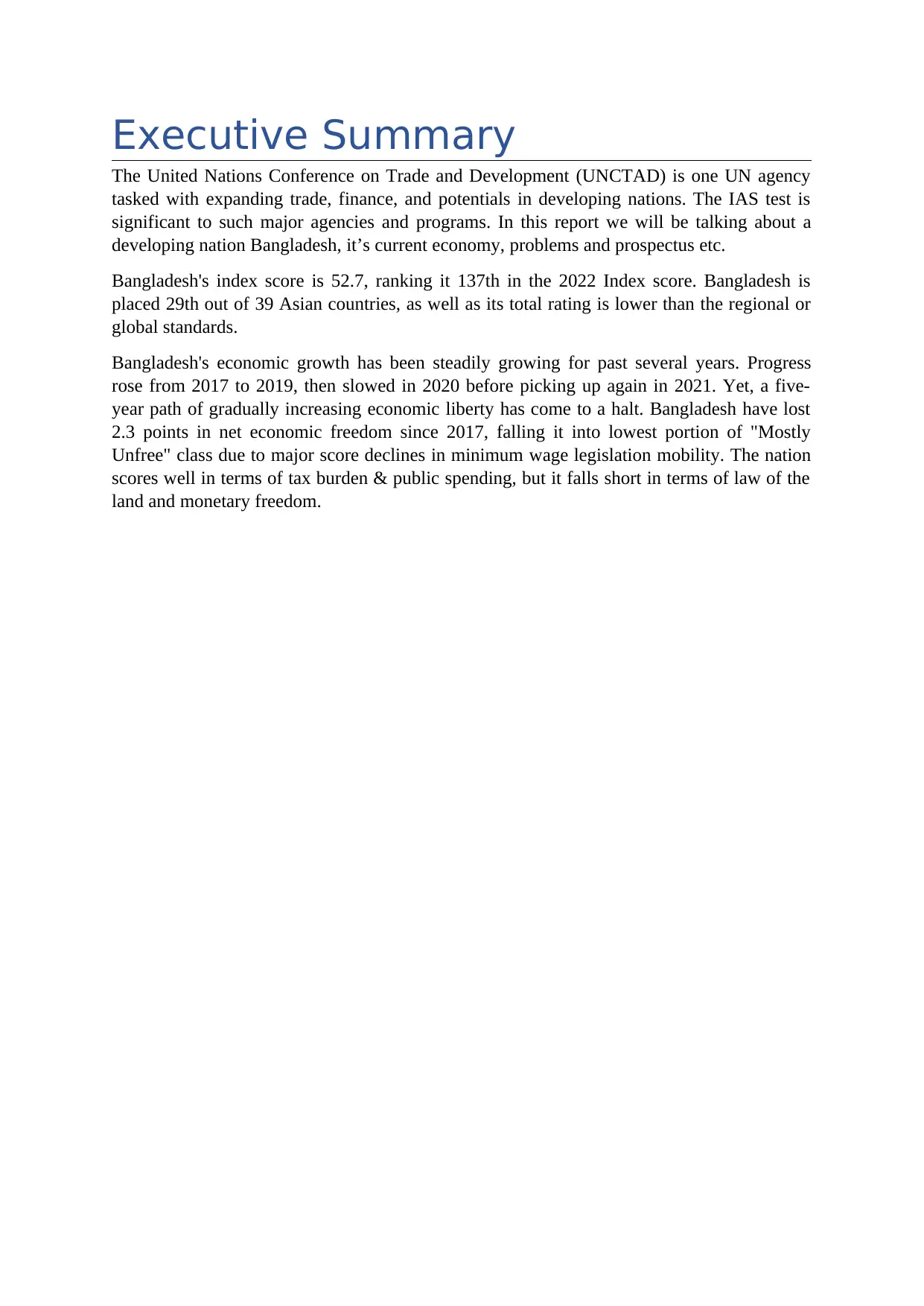
Executive Summary
The United Nations Conference on Trade and Development (UNCTAD) is one UN agency
tasked with expanding trade, finance, and potentials in developing nations. The IAS test is
significant to such major agencies and programs. In this report we will be talking about a
developing nation Bangladesh, it’s current economy, problems and prospectus etc.
Bangladesh's index score is 52.7, ranking it 137th in the 2022 Index score. Bangladesh is
placed 29th out of 39 Asian countries, as well as its total rating is lower than the regional or
global standards.
Bangladesh's economic growth has been steadily growing for past several years. Progress
rose from 2017 to 2019, then slowed in 2020 before picking up again in 2021. Yet, a five-
year path of gradually increasing economic liberty has come to a halt. Bangladesh have lost
2.3 points in net economic freedom since 2017, falling it into lowest portion of "Mostly
Unfree" class due to major score declines in minimum wage legislation mobility. The nation
scores well in terms of tax burden & public spending, but it falls short in terms of law of the
land and monetary freedom.
The United Nations Conference on Trade and Development (UNCTAD) is one UN agency
tasked with expanding trade, finance, and potentials in developing nations. The IAS test is
significant to such major agencies and programs. In this report we will be talking about a
developing nation Bangladesh, it’s current economy, problems and prospectus etc.
Bangladesh's index score is 52.7, ranking it 137th in the 2022 Index score. Bangladesh is
placed 29th out of 39 Asian countries, as well as its total rating is lower than the regional or
global standards.
Bangladesh's economic growth has been steadily growing for past several years. Progress
rose from 2017 to 2019, then slowed in 2020 before picking up again in 2021. Yet, a five-
year path of gradually increasing economic liberty has come to a halt. Bangladesh have lost
2.3 points in net economic freedom since 2017, falling it into lowest portion of "Mostly
Unfree" class due to major score declines in minimum wage legislation mobility. The nation
scores well in terms of tax burden & public spending, but it falls short in terms of law of the
land and monetary freedom.
Paraphrase This Document
Need a fresh take? Get an instant paraphrase of this document with our AI Paraphraser
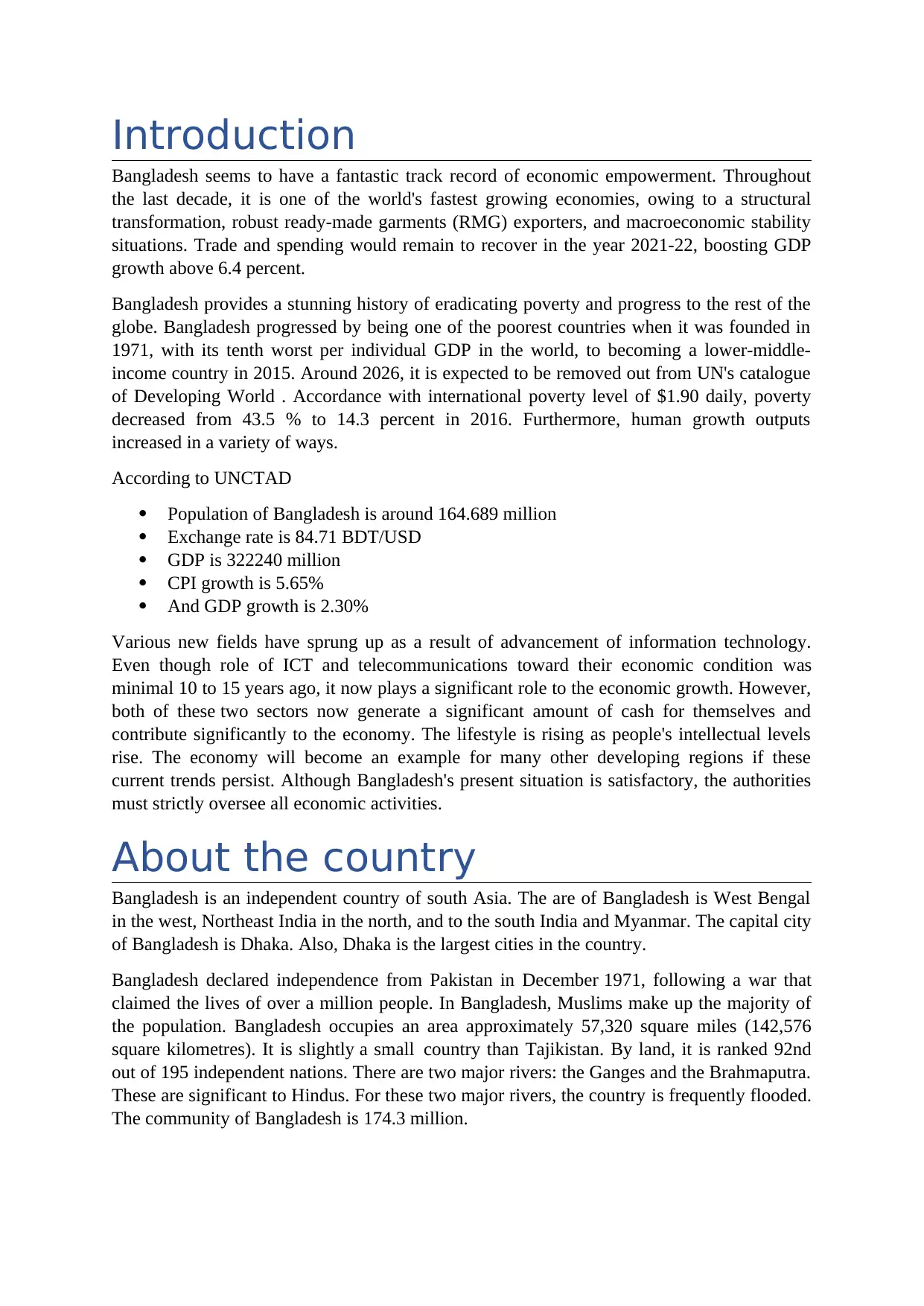
Introduction
Bangladesh seems to have a fantastic track record of economic empowerment. Throughout
the last decade, it is one of the world's fastest growing economies, owing to a structural
transformation, robust ready-made garments (RMG) exporters, and macroeconomic stability
situations. Trade and spending would remain to recover in the year 2021-22, boosting GDP
growth above 6.4 percent.
Bangladesh provides a stunning history of eradicating poverty and progress to the rest of the
globe. Bangladesh progressed by being one of the poorest countries when it was founded in
1971, with its tenth worst per individual GDP in the world, to becoming a lower-middle-
income country in 2015. Around 2026, it is expected to be removed out from UN's catalogue
of Developing World . Accordance with international poverty level of $1.90 daily, poverty
decreased from 43.5 % to 14.3 percent in 2016. Furthermore, human growth outputs
increased in a variety of ways.
According to UNCTAD
Population of Bangladesh is around 164.689 million
Exchange rate is 84.71 BDT/USD
GDP is 322240 million
CPI growth is 5.65%
And GDP growth is 2.30%
Various new fields have sprung up as a result of advancement of information technology.
Even though role of ICT and telecommunications toward their economic condition was
minimal 10 to 15 years ago, it now plays a significant role to the economic growth. However,
both of these two sectors now generate a significant amount of cash for themselves and
contribute significantly to the economy. The lifestyle is rising as people's intellectual levels
rise. The economy will become an example for many other developing regions if these
current trends persist. Although Bangladesh's present situation is satisfactory, the authorities
must strictly oversee all economic activities.
About the country
Bangladesh is an independent country of south Asia. The are of Bangladesh is West Bengal
in the west, Northeast India in the north, and to the south India and Myanmar. The capital city
of Bangladesh is Dhaka. Also, Dhaka is the largest cities in the country.
Bangladesh declared independence from Pakistan in December 1971, following a war that
claimed the lives of over a million people. In Bangladesh, Muslims make up the majority of
the population. Bangladesh occupies an area approximately 57,320 square miles (142,576
square kilometres). It is slightly a small country than Tajikistan. By land, it is ranked 92nd
out of 195 independent nations. There are two major rivers: the Ganges and the Brahmaputra.
These are significant to Hindus. For these two major rivers, the country is frequently flooded.
The community of Bangladesh is 174.3 million.
Bangladesh seems to have a fantastic track record of economic empowerment. Throughout
the last decade, it is one of the world's fastest growing economies, owing to a structural
transformation, robust ready-made garments (RMG) exporters, and macroeconomic stability
situations. Trade and spending would remain to recover in the year 2021-22, boosting GDP
growth above 6.4 percent.
Bangladesh provides a stunning history of eradicating poverty and progress to the rest of the
globe. Bangladesh progressed by being one of the poorest countries when it was founded in
1971, with its tenth worst per individual GDP in the world, to becoming a lower-middle-
income country in 2015. Around 2026, it is expected to be removed out from UN's catalogue
of Developing World . Accordance with international poverty level of $1.90 daily, poverty
decreased from 43.5 % to 14.3 percent in 2016. Furthermore, human growth outputs
increased in a variety of ways.
According to UNCTAD
Population of Bangladesh is around 164.689 million
Exchange rate is 84.71 BDT/USD
GDP is 322240 million
CPI growth is 5.65%
And GDP growth is 2.30%
Various new fields have sprung up as a result of advancement of information technology.
Even though role of ICT and telecommunications toward their economic condition was
minimal 10 to 15 years ago, it now plays a significant role to the economic growth. However,
both of these two sectors now generate a significant amount of cash for themselves and
contribute significantly to the economy. The lifestyle is rising as people's intellectual levels
rise. The economy will become an example for many other developing regions if these
current trends persist. Although Bangladesh's present situation is satisfactory, the authorities
must strictly oversee all economic activities.
About the country
Bangladesh is an independent country of south Asia. The are of Bangladesh is West Bengal
in the west, Northeast India in the north, and to the south India and Myanmar. The capital city
of Bangladesh is Dhaka. Also, Dhaka is the largest cities in the country.
Bangladesh declared independence from Pakistan in December 1971, following a war that
claimed the lives of over a million people. In Bangladesh, Muslims make up the majority of
the population. Bangladesh occupies an area approximately 57,320 square miles (142,576
square kilometres). It is slightly a small country than Tajikistan. By land, it is ranked 92nd
out of 195 independent nations. There are two major rivers: the Ganges and the Brahmaputra.
These are significant to Hindus. For these two major rivers, the country is frequently flooded.
The community of Bangladesh is 174.3 million.
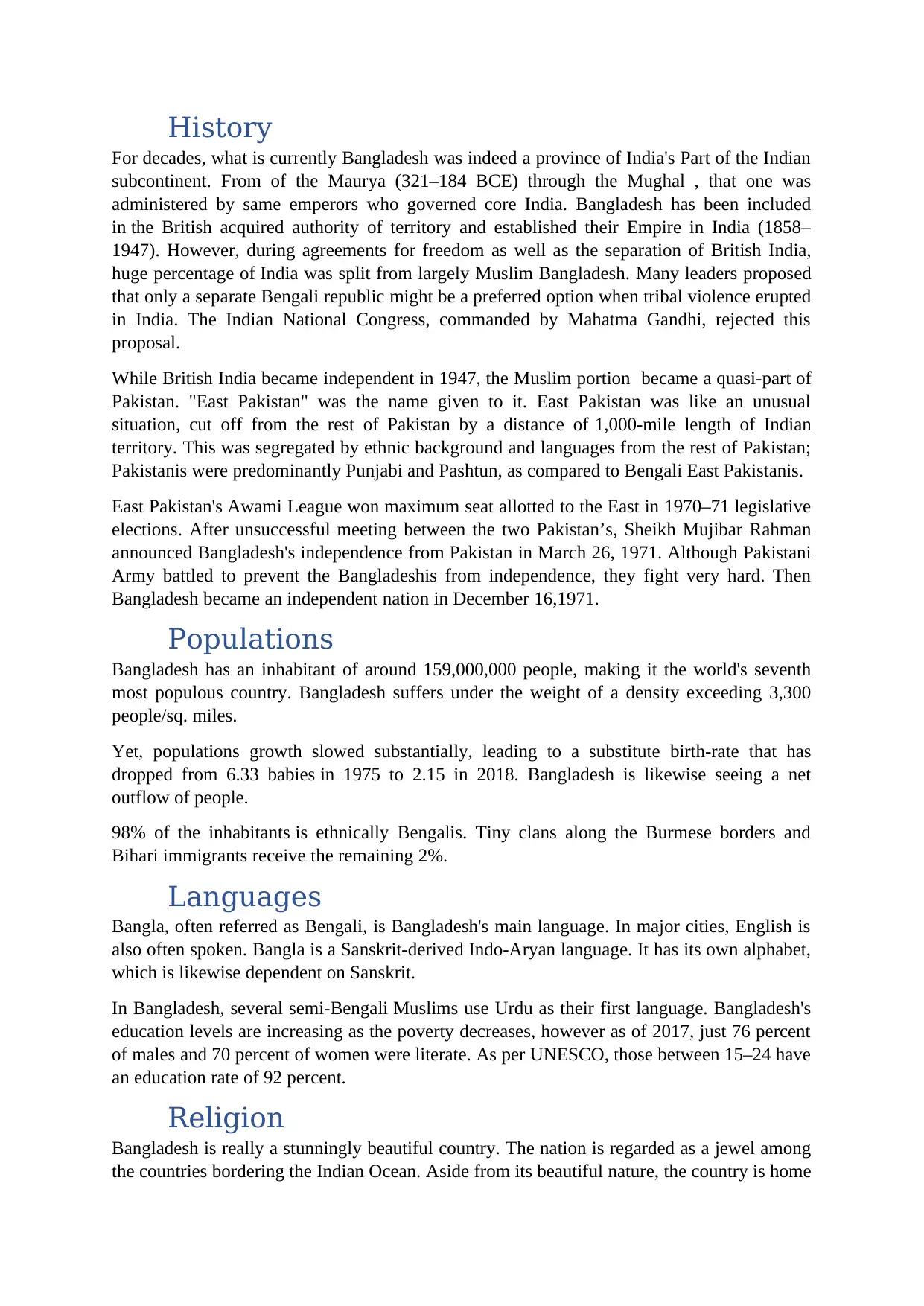
History
For decades, what is currently Bangladesh was indeed a province of India's Part of the Indian
subcontinent. From of the Maurya (321–184 BCE) through the Mughal , that one was
administered by same emperors who governed core India. Bangladesh has been included
in the British acquired authority of territory and established their Empire in India (1858–
1947). However, during agreements for freedom as well as the separation of British India,
huge percentage of India was split from largely Muslim Bangladesh. Many leaders proposed
that only a separate Bengali republic might be a preferred option when tribal violence erupted
in India. The Indian National Congress, commanded by Mahatma Gandhi, rejected this
proposal.
While British India became independent in 1947, the Muslim portion became a quasi-part of
Pakistan. "East Pakistan" was the name given to it. East Pakistan was like an unusual
situation, cut off from the rest of Pakistan by a distance of 1,000-mile length of Indian
territory. This was segregated by ethnic background and languages from the rest of Pakistan;
Pakistanis were predominantly Punjabi and Pashtun, as compared to Bengali East Pakistanis.
East Pakistan's Awami League won maximum seat allotted to the East in 1970–71 legislative
elections. After unsuccessful meeting between the two Pakistan’s, Sheikh Mujibar Rahman
announced Bangladesh's independence from Pakistan in March 26, 1971. Although Pakistani
Army battled to prevent the Bangladeshis from independence, they fight very hard. Then
Bangladesh became an independent nation in December 16,1971.
Populations
Bangladesh has an inhabitant of around 159,000,000 people, making it the world's seventh
most populous country. Bangladesh suffers under the weight of a density exceeding 3,300
people/sq. miles.
Yet, populations growth slowed substantially, leading to a substitute birth-rate that has
dropped from 6.33 babies in 1975 to 2.15 in 2018. Bangladesh is likewise seeing a net
outflow of people.
98% of the inhabitants is ethnically Bengalis. Tiny clans along the Burmese borders and
Bihari immigrants receive the remaining 2%.
Languages
Bangla, often referred as Bengali, is Bangladesh's main language. In major cities, English is
also often spoken. Bangla is a Sanskrit-derived Indo-Aryan language. It has its own alphabet,
which is likewise dependent on Sanskrit.
In Bangladesh, several semi-Bengali Muslims use Urdu as their first language. Bangladesh's
education levels are increasing as the poverty decreases, however as of 2017, just 76 percent
of males and 70 percent of women were literate. As per UNESCO, those between 15–24 have
an education rate of 92 percent.
Religion
Bangladesh is really a stunningly beautiful country. The nation is regarded as a jewel among
the countries bordering the Indian Ocean. Aside from its beautiful nature, the country is home
For decades, what is currently Bangladesh was indeed a province of India's Part of the Indian
subcontinent. From of the Maurya (321–184 BCE) through the Mughal , that one was
administered by same emperors who governed core India. Bangladesh has been included
in the British acquired authority of territory and established their Empire in India (1858–
1947). However, during agreements for freedom as well as the separation of British India,
huge percentage of India was split from largely Muslim Bangladesh. Many leaders proposed
that only a separate Bengali republic might be a preferred option when tribal violence erupted
in India. The Indian National Congress, commanded by Mahatma Gandhi, rejected this
proposal.
While British India became independent in 1947, the Muslim portion became a quasi-part of
Pakistan. "East Pakistan" was the name given to it. East Pakistan was like an unusual
situation, cut off from the rest of Pakistan by a distance of 1,000-mile length of Indian
territory. This was segregated by ethnic background and languages from the rest of Pakistan;
Pakistanis were predominantly Punjabi and Pashtun, as compared to Bengali East Pakistanis.
East Pakistan's Awami League won maximum seat allotted to the East in 1970–71 legislative
elections. After unsuccessful meeting between the two Pakistan’s, Sheikh Mujibar Rahman
announced Bangladesh's independence from Pakistan in March 26, 1971. Although Pakistani
Army battled to prevent the Bangladeshis from independence, they fight very hard. Then
Bangladesh became an independent nation in December 16,1971.
Populations
Bangladesh has an inhabitant of around 159,000,000 people, making it the world's seventh
most populous country. Bangladesh suffers under the weight of a density exceeding 3,300
people/sq. miles.
Yet, populations growth slowed substantially, leading to a substitute birth-rate that has
dropped from 6.33 babies in 1975 to 2.15 in 2018. Bangladesh is likewise seeing a net
outflow of people.
98% of the inhabitants is ethnically Bengalis. Tiny clans along the Burmese borders and
Bihari immigrants receive the remaining 2%.
Languages
Bangla, often referred as Bengali, is Bangladesh's main language. In major cities, English is
also often spoken. Bangla is a Sanskrit-derived Indo-Aryan language. It has its own alphabet,
which is likewise dependent on Sanskrit.
In Bangladesh, several semi-Bengali Muslims use Urdu as their first language. Bangladesh's
education levels are increasing as the poverty decreases, however as of 2017, just 76 percent
of males and 70 percent of women were literate. As per UNESCO, those between 15–24 have
an education rate of 92 percent.
Religion
Bangladesh is really a stunningly beautiful country. The nation is regarded as a jewel among
the countries bordering the Indian Ocean. Aside from its beautiful nature, the country is home
⊘ This is a preview!⊘
Do you want full access?
Subscribe today to unlock all pages.

Trusted by 1+ million students worldwide
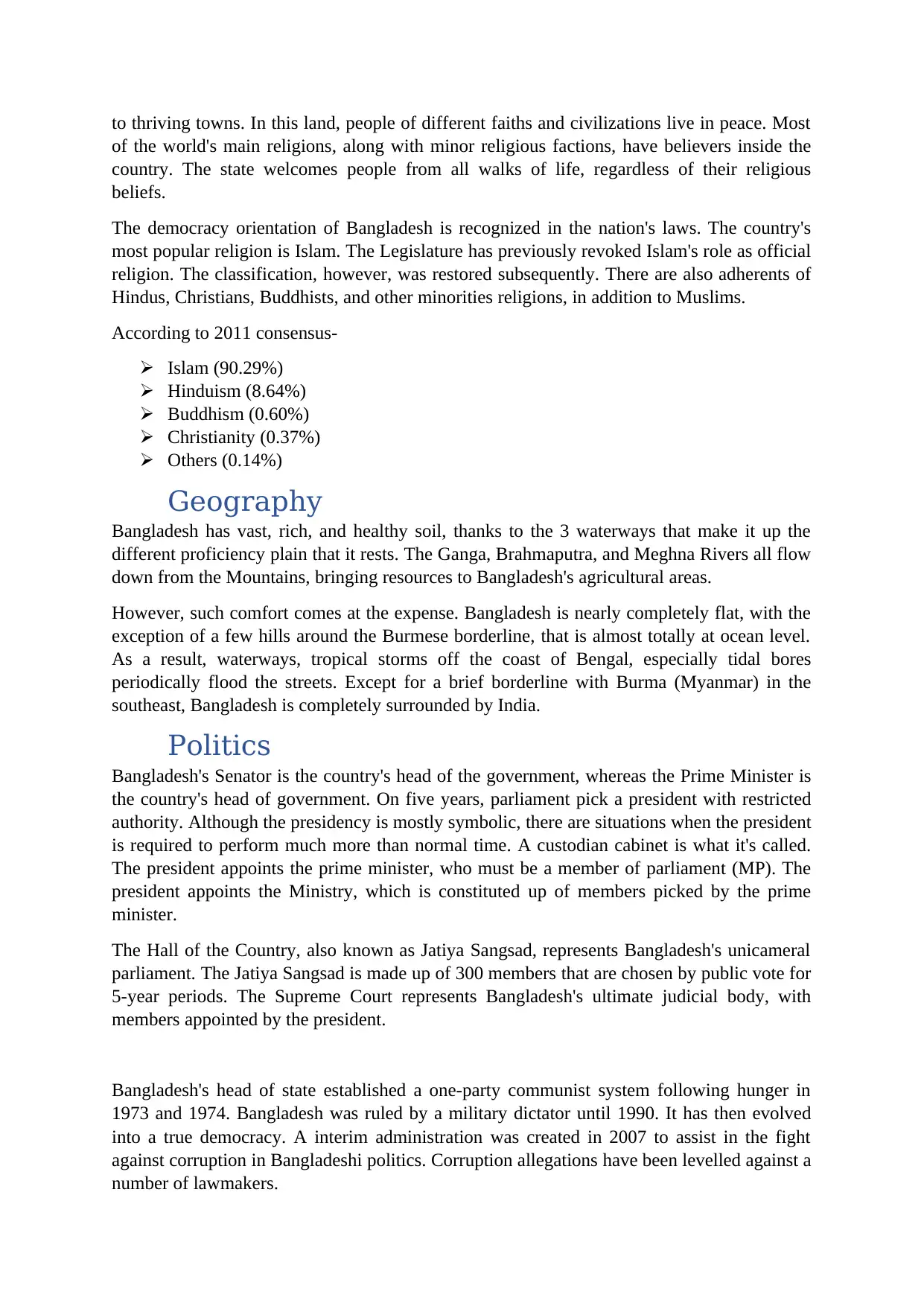
to thriving towns. In this land, people of different faiths and civilizations live in peace. Most
of the world's main religions, along with minor religious factions, have believers inside the
country. The state welcomes people from all walks of life, regardless of their religious
beliefs.
The democracy orientation of Bangladesh is recognized in the nation's laws. The country's
most popular religion is Islam. The Legislature has previously revoked Islam's role as official
religion. The classification, however, was restored subsequently. There are also adherents of
Hindus, Christians, Buddhists, and other minorities religions, in addition to Muslims.
According to 2011 consensus-
Islam (90.29%)
Hinduism (8.64%)
Buddhism (0.60%)
Christianity (0.37%)
Others (0.14%)
Geography
Bangladesh has vast, rich, and healthy soil, thanks to the 3 waterways that make it up the
different proficiency plain that it rests. The Ganga, Brahmaputra, and Meghna Rivers all flow
down from the Mountains, bringing resources to Bangladesh's agricultural areas.
However, such comfort comes at the expense. Bangladesh is nearly completely flat, with the
exception of a few hills around the Burmese borderline, that is almost totally at ocean level.
As a result, waterways, tropical storms off the coast of Bengal, especially tidal bores
periodically flood the streets. Except for a brief borderline with Burma (Myanmar) in the
southeast, Bangladesh is completely surrounded by India.
Politics
Bangladesh's Senator is the country's head of the government, whereas the Prime Minister is
the country's head of government. On five years, parliament pick a president with restricted
authority. Although the presidency is mostly symbolic, there are situations when the president
is required to perform much more than normal time. A custodian cabinet is what it's called.
The president appoints the prime minister, who must be a member of parliament (MP). The
president appoints the Ministry, which is constituted up of members picked by the prime
minister.
The Hall of the Country, also known as Jatiya Sangsad, represents Bangladesh's unicameral
parliament. The Jatiya Sangsad is made up of 300 members that are chosen by public vote for
5-year periods. The Supreme Court represents Bangladesh's ultimate judicial body, with
members appointed by the president.
Bangladesh's head of state established a one-party communist system following hunger in
1973 and 1974. Bangladesh was ruled by a military dictator until 1990. It has then evolved
into a true democracy. A interim administration was created in 2007 to assist in the fight
against corruption in Bangladeshi politics. Corruption allegations have been levelled against a
number of lawmakers.
of the world's main religions, along with minor religious factions, have believers inside the
country. The state welcomes people from all walks of life, regardless of their religious
beliefs.
The democracy orientation of Bangladesh is recognized in the nation's laws. The country's
most popular religion is Islam. The Legislature has previously revoked Islam's role as official
religion. The classification, however, was restored subsequently. There are also adherents of
Hindus, Christians, Buddhists, and other minorities religions, in addition to Muslims.
According to 2011 consensus-
Islam (90.29%)
Hinduism (8.64%)
Buddhism (0.60%)
Christianity (0.37%)
Others (0.14%)
Geography
Bangladesh has vast, rich, and healthy soil, thanks to the 3 waterways that make it up the
different proficiency plain that it rests. The Ganga, Brahmaputra, and Meghna Rivers all flow
down from the Mountains, bringing resources to Bangladesh's agricultural areas.
However, such comfort comes at the expense. Bangladesh is nearly completely flat, with the
exception of a few hills around the Burmese borderline, that is almost totally at ocean level.
As a result, waterways, tropical storms off the coast of Bengal, especially tidal bores
periodically flood the streets. Except for a brief borderline with Burma (Myanmar) in the
southeast, Bangladesh is completely surrounded by India.
Politics
Bangladesh's Senator is the country's head of the government, whereas the Prime Minister is
the country's head of government. On five years, parliament pick a president with restricted
authority. Although the presidency is mostly symbolic, there are situations when the president
is required to perform much more than normal time. A custodian cabinet is what it's called.
The president appoints the prime minister, who must be a member of parliament (MP). The
president appoints the Ministry, which is constituted up of members picked by the prime
minister.
The Hall of the Country, also known as Jatiya Sangsad, represents Bangladesh's unicameral
parliament. The Jatiya Sangsad is made up of 300 members that are chosen by public vote for
5-year periods. The Supreme Court represents Bangladesh's ultimate judicial body, with
members appointed by the president.
Bangladesh's head of state established a one-party communist system following hunger in
1973 and 1974. Bangladesh was ruled by a military dictator until 1990. It has then evolved
into a true democracy. A interim administration was created in 2007 to assist in the fight
against corruption in Bangladeshi politics. Corruption allegations have been levelled against a
number of lawmakers.
Paraphrase This Document
Need a fresh take? Get an instant paraphrase of this document with our AI Paraphraser
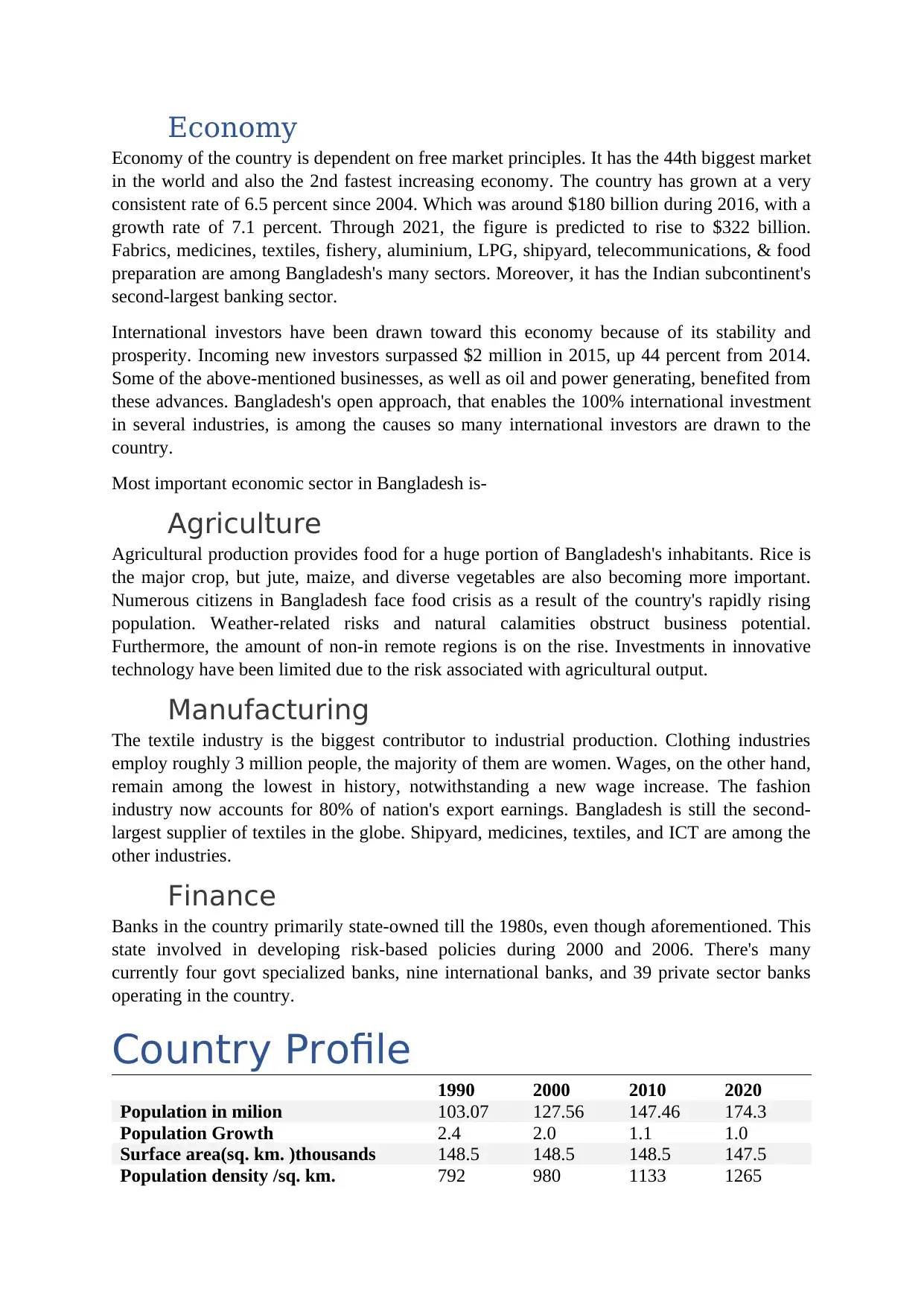
Economy
Economy of the country is dependent on free market principles. It has the 44th biggest market
in the world and also the 2nd fastest increasing economy. The country has grown at a very
consistent rate of 6.5 percent since 2004. Which was around $180 billion during 2016, with a
growth rate of 7.1 percent. Through 2021, the figure is predicted to rise to $322 billion.
Fabrics, medicines, textiles, fishery, aluminium, LPG, shipyard, telecommunications, & food
preparation are among Bangladesh's many sectors. Moreover, it has the Indian subcontinent's
second-largest banking sector.
International investors have been drawn toward this economy because of its stability and
prosperity. Incoming new investors surpassed $2 million in 2015, up 44 percent from 2014.
Some of the above-mentioned businesses, as well as oil and power generating, benefited from
these advances. Bangladesh's open approach, that enables the 100% international investment
in several industries, is among the causes so many international investors are drawn to the
country.
Most important economic sector in Bangladesh is-
Agriculture
Agricultural production provides food for a huge portion of Bangladesh's inhabitants. Rice is
the major crop, but jute, maize, and diverse vegetables are also becoming more important.
Numerous citizens in Bangladesh face food crisis as a result of the country's rapidly rising
population. Weather-related risks and natural calamities obstruct business potential.
Furthermore, the amount of non-in remote regions is on the rise. Investments in innovative
technology have been limited due to the risk associated with agricultural output.
Manufacturing
The textile industry is the biggest contributor to industrial production. Clothing industries
employ roughly 3 million people, the majority of them are women. Wages, on the other hand,
remain among the lowest in history, notwithstanding a new wage increase. The fashion
industry now accounts for 80% of nation's export earnings. Bangladesh is still the second-
largest supplier of textiles in the globe. Shipyard, medicines, textiles, and ICT are among the
other industries.
Finance
Banks in the country primarily state-owned till the 1980s, even though aforementioned. This
state involved in developing risk-based policies during 2000 and 2006. There's many
currently four govt specialized banks, nine international banks, and 39 private sector banks
operating in the country.
Country Profile 1990 2000 2010 2020
Population in milion 103.07 127.56 147.46 174.3
Population Growth 2.4 2.0 1.1 1.0
Surface area(sq. km. )thousands 148.5 148.5 148.5 147.5
Population density /sq. km. 792 980 1133 1265
Economy of the country is dependent on free market principles. It has the 44th biggest market
in the world and also the 2nd fastest increasing economy. The country has grown at a very
consistent rate of 6.5 percent since 2004. Which was around $180 billion during 2016, with a
growth rate of 7.1 percent. Through 2021, the figure is predicted to rise to $322 billion.
Fabrics, medicines, textiles, fishery, aluminium, LPG, shipyard, telecommunications, & food
preparation are among Bangladesh's many sectors. Moreover, it has the Indian subcontinent's
second-largest banking sector.
International investors have been drawn toward this economy because of its stability and
prosperity. Incoming new investors surpassed $2 million in 2015, up 44 percent from 2014.
Some of the above-mentioned businesses, as well as oil and power generating, benefited from
these advances. Bangladesh's open approach, that enables the 100% international investment
in several industries, is among the causes so many international investors are drawn to the
country.
Most important economic sector in Bangladesh is-
Agriculture
Agricultural production provides food for a huge portion of Bangladesh's inhabitants. Rice is
the major crop, but jute, maize, and diverse vegetables are also becoming more important.
Numerous citizens in Bangladesh face food crisis as a result of the country's rapidly rising
population. Weather-related risks and natural calamities obstruct business potential.
Furthermore, the amount of non-in remote regions is on the rise. Investments in innovative
technology have been limited due to the risk associated with agricultural output.
Manufacturing
The textile industry is the biggest contributor to industrial production. Clothing industries
employ roughly 3 million people, the majority of them are women. Wages, on the other hand,
remain among the lowest in history, notwithstanding a new wage increase. The fashion
industry now accounts for 80% of nation's export earnings. Bangladesh is still the second-
largest supplier of textiles in the globe. Shipyard, medicines, textiles, and ICT are among the
other industries.
Finance
Banks in the country primarily state-owned till the 1980s, even though aforementioned. This
state involved in developing risk-based policies during 2000 and 2006. There's many
currently four govt specialized banks, nine international banks, and 39 private sector banks
operating in the country.
Country Profile 1990 2000 2010 2020
Population in milion 103.07 127.56 147.46 174.3
Population Growth 2.4 2.0 1.1 1.0
Surface area(sq. km. )thousands 148.5 148.5 148.5 147.5
Population density /sq. km. 792 980 1133 1265
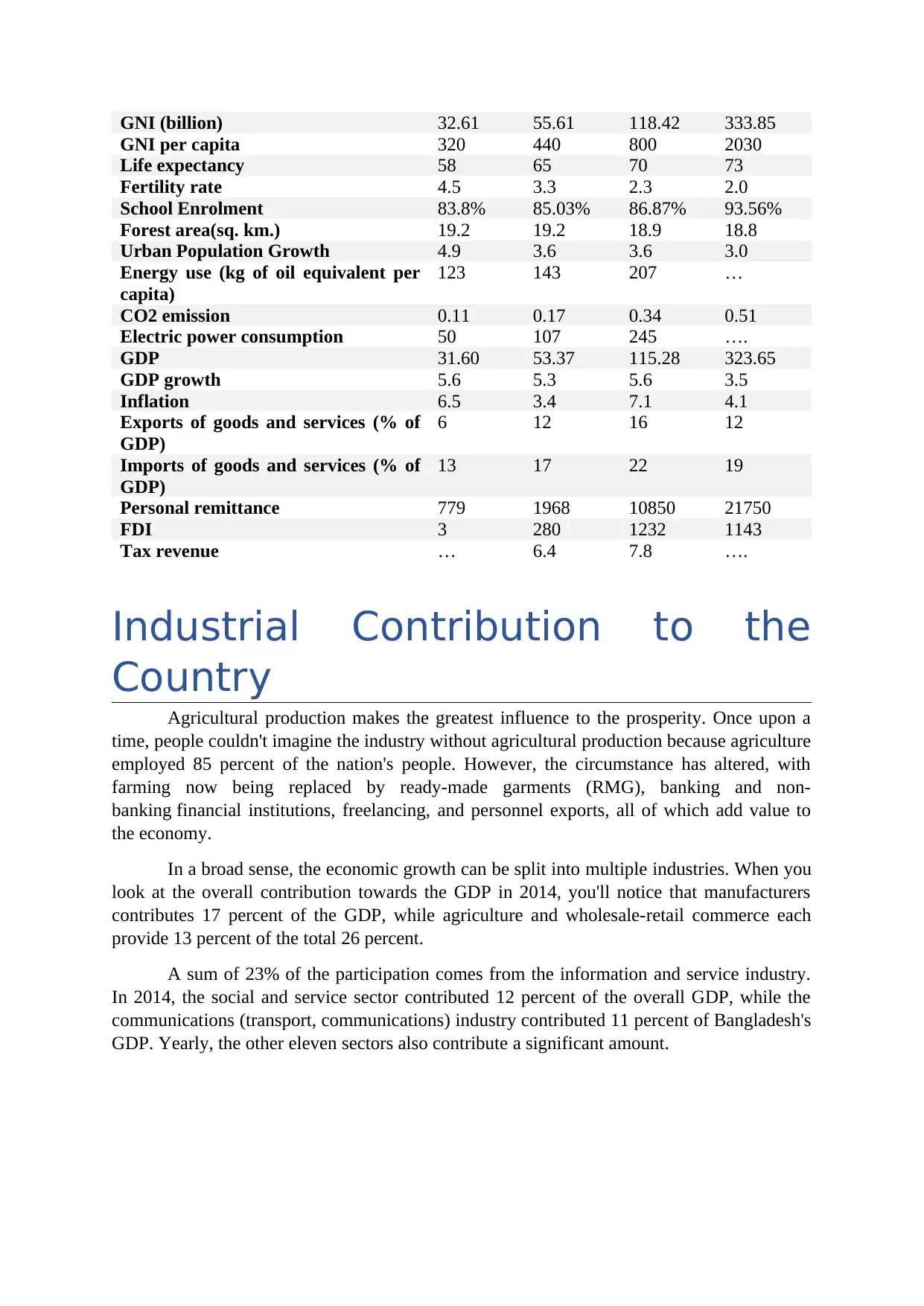
GNI (billion) 32.61 55.61 118.42 333.85
GNI per capita 320 440 800 2030
Life expectancy 58 65 70 73
Fertility rate 4.5 3.3 2.3 2.0
School Enrolment 83.8% 85.03% 86.87% 93.56%
Forest area(sq. km.) 19.2 19.2 18.9 18.8
Urban Population Growth 4.9 3.6 3.6 3.0
Energy use (kg of oil equivalent per
capita)
123 143 207 …
CO2 emission 0.11 0.17 0.34 0.51
Electric power consumption 50 107 245 ….
GDP 31.60 53.37 115.28 323.65
GDP growth 5.6 5.3 5.6 3.5
Inflation 6.5 3.4 7.1 4.1
Exports of goods and services (% of
GDP)
6 12 16 12
Imports of goods and services (% of
GDP)
13 17 22 19
Personal remittance 779 1968 10850 21750
FDI 3 280 1232 1143
Tax revenue … 6.4 7.8 ….
Industrial Contribution to the
Country
Agricultural production makes the greatest influence to the prosperity. Once upon a
time, people couldn't imagine the industry without agricultural production because agriculture
employed 85 percent of the nation's people. However, the circumstance has altered, with
farming now being replaced by ready-made garments (RMG), banking and non-
banking financial institutions, freelancing, and personnel exports, all of which add value to
the economy.
In a broad sense, the economic growth can be split into multiple industries. When you
look at the overall contribution towards the GDP in 2014, you'll notice that manufacturers
contributes 17 percent of the GDP, while agriculture and wholesale-retail commerce each
provide 13 percent of the total 26 percent.
A sum of 23% of the participation comes from the information and service industry.
In 2014, the social and service sector contributed 12 percent of the overall GDP, while the
communications (transport, communications) industry contributed 11 percent of Bangladesh's
GDP. Yearly, the other eleven sectors also contribute a significant amount.
GNI per capita 320 440 800 2030
Life expectancy 58 65 70 73
Fertility rate 4.5 3.3 2.3 2.0
School Enrolment 83.8% 85.03% 86.87% 93.56%
Forest area(sq. km.) 19.2 19.2 18.9 18.8
Urban Population Growth 4.9 3.6 3.6 3.0
Energy use (kg of oil equivalent per
capita)
123 143 207 …
CO2 emission 0.11 0.17 0.34 0.51
Electric power consumption 50 107 245 ….
GDP 31.60 53.37 115.28 323.65
GDP growth 5.6 5.3 5.6 3.5
Inflation 6.5 3.4 7.1 4.1
Exports of goods and services (% of
GDP)
6 12 16 12
Imports of goods and services (% of
GDP)
13 17 22 19
Personal remittance 779 1968 10850 21750
FDI 3 280 1232 1143
Tax revenue … 6.4 7.8 ….
Industrial Contribution to the
Country
Agricultural production makes the greatest influence to the prosperity. Once upon a
time, people couldn't imagine the industry without agricultural production because agriculture
employed 85 percent of the nation's people. However, the circumstance has altered, with
farming now being replaced by ready-made garments (RMG), banking and non-
banking financial institutions, freelancing, and personnel exports, all of which add value to
the economy.
In a broad sense, the economic growth can be split into multiple industries. When you
look at the overall contribution towards the GDP in 2014, you'll notice that manufacturers
contributes 17 percent of the GDP, while agriculture and wholesale-retail commerce each
provide 13 percent of the total 26 percent.
A sum of 23% of the participation comes from the information and service industry.
In 2014, the social and service sector contributed 12 percent of the overall GDP, while the
communications (transport, communications) industry contributed 11 percent of Bangladesh's
GDP. Yearly, the other eleven sectors also contribute a significant amount.
⊘ This is a preview!⊘
Do you want full access?
Subscribe today to unlock all pages.

Trusted by 1+ million students worldwide
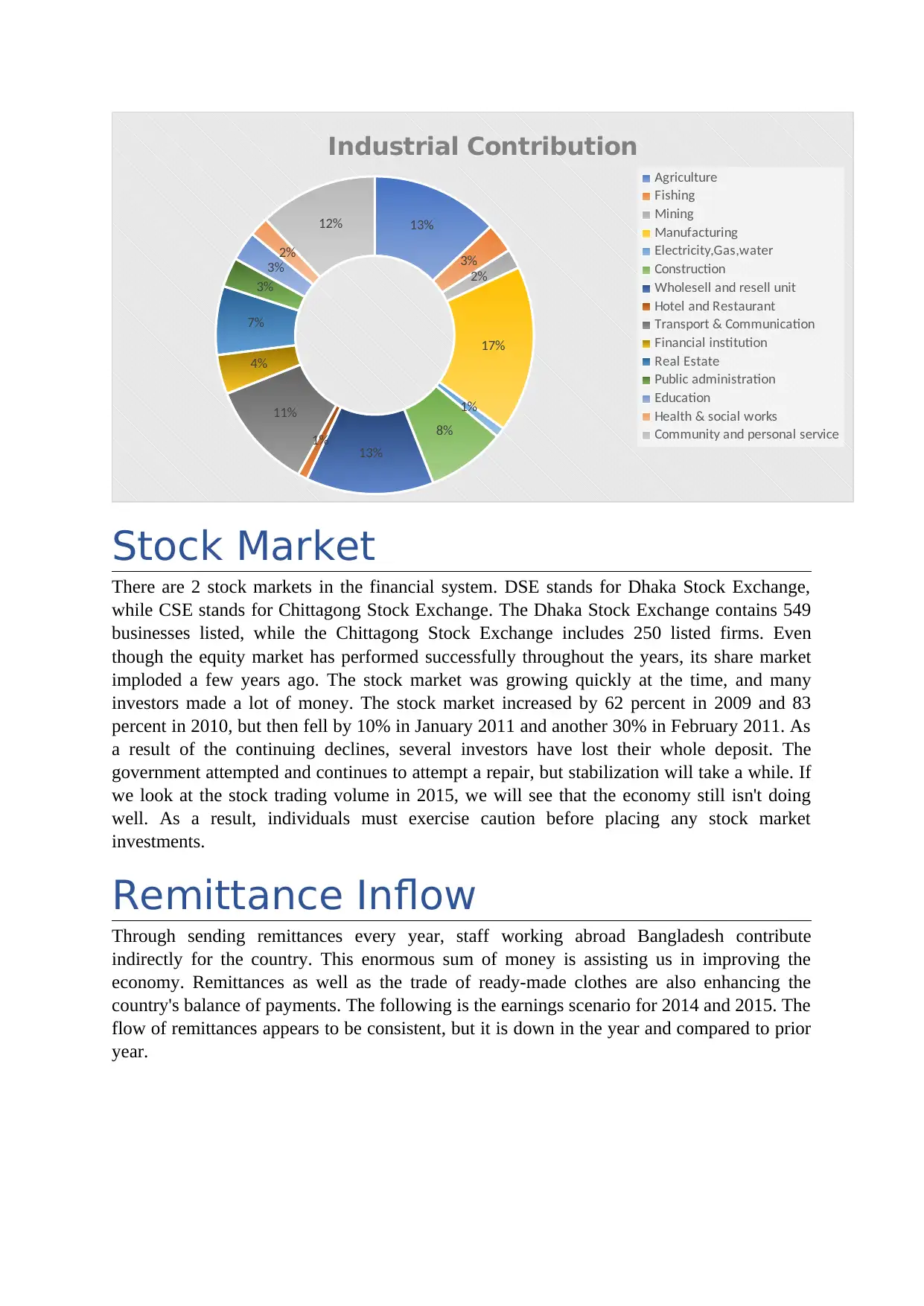
13%
3%
2%
17%
1%
8%
13%
1%
11%
4%
7%
3%
3%
2%
12%
Industrial Contribution
Agriculture
Fishing
Mining
Manufacturing
Electricity,Gas,water
Construction
Wholesell and resell unit
Hotel and Restaurant
Transport & Communication
Financial institution
Real Estate
Public administration
Education
Health & social works
Community and personal service
Stock Market
There are 2 stock markets in the financial system. DSE stands for Dhaka Stock Exchange,
while CSE stands for Chittagong Stock Exchange. The Dhaka Stock Exchange contains 549
businesses listed, while the Chittagong Stock Exchange includes 250 listed firms. Even
though the equity market has performed successfully throughout the years, its share market
imploded a few years ago. The stock market was growing quickly at the time, and many
investors made a lot of money. The stock market increased by 62 percent in 2009 and 83
percent in 2010, but then fell by 10% in January 2011 and another 30% in February 2011. As
a result of the continuing declines, several investors have lost their whole deposit. The
government attempted and continues to attempt a repair, but stabilization will take a while. If
we look at the stock trading volume in 2015, we will see that the economy still isn't doing
well. As a result, individuals must exercise caution before placing any stock market
investments.
Remittance Inflow
Through sending remittances every year, staff working abroad Bangladesh contribute
indirectly for the country. This enormous sum of money is assisting us in improving the
economy. Remittances as well as the trade of ready-made clothes are also enhancing the
country's balance of payments. The following is the earnings scenario for 2014 and 2015. The
flow of remittances appears to be consistent, but it is down in the year and compared to prior
year.
3%
2%
17%
1%
8%
13%
1%
11%
4%
7%
3%
3%
2%
12%
Industrial Contribution
Agriculture
Fishing
Mining
Manufacturing
Electricity,Gas,water
Construction
Wholesell and resell unit
Hotel and Restaurant
Transport & Communication
Financial institution
Real Estate
Public administration
Education
Health & social works
Community and personal service
Stock Market
There are 2 stock markets in the financial system. DSE stands for Dhaka Stock Exchange,
while CSE stands for Chittagong Stock Exchange. The Dhaka Stock Exchange contains 549
businesses listed, while the Chittagong Stock Exchange includes 250 listed firms. Even
though the equity market has performed successfully throughout the years, its share market
imploded a few years ago. The stock market was growing quickly at the time, and many
investors made a lot of money. The stock market increased by 62 percent in 2009 and 83
percent in 2010, but then fell by 10% in January 2011 and another 30% in February 2011. As
a result of the continuing declines, several investors have lost their whole deposit. The
government attempted and continues to attempt a repair, but stabilization will take a while. If
we look at the stock trading volume in 2015, we will see that the economy still isn't doing
well. As a result, individuals must exercise caution before placing any stock market
investments.
Remittance Inflow
Through sending remittances every year, staff working abroad Bangladesh contribute
indirectly for the country. This enormous sum of money is assisting us in improving the
economy. Remittances as well as the trade of ready-made clothes are also enhancing the
country's balance of payments. The following is the earnings scenario for 2014 and 2015. The
flow of remittances appears to be consistent, but it is down in the year and compared to prior
year.
Paraphrase This Document
Need a fresh take? Get an instant paraphrase of this document with our AI Paraphraser
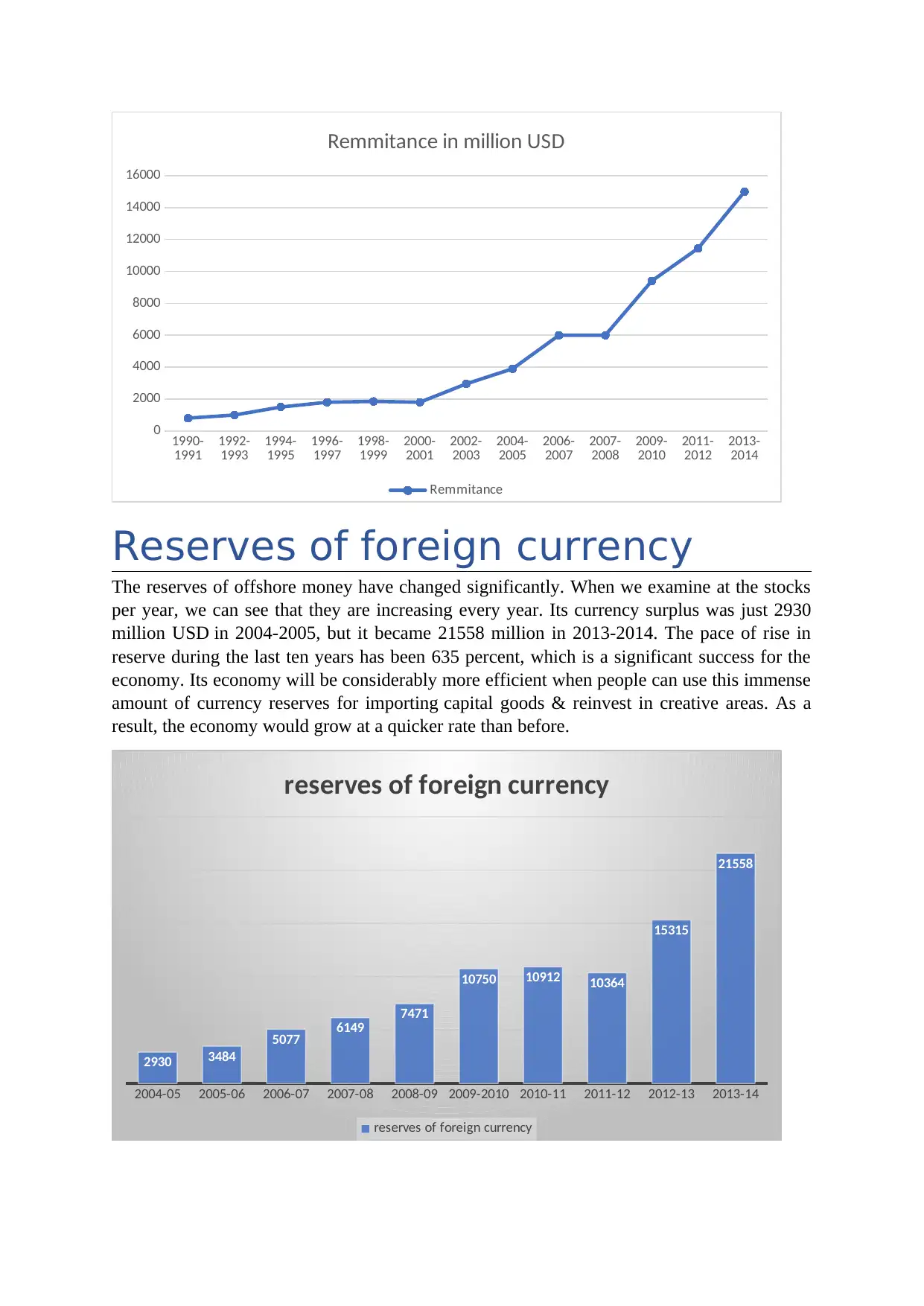
1990-
1991 1992-
1993 1994-
1995 1996-
1997 1998-
1999 2000-
2001 2002-
2003 2004-
2005 2006-
2007 2007-
2008 2009-
2010 2011-
2012 2013-
2014
0
2000
4000
6000
8000
10000
12000
14000
16000
Remmitance in million USD
Remmitance
Reserves of foreign currency
The reserves of offshore money have changed significantly. When we examine at the stocks
per year, we can see that they are increasing every year. Its currency surplus was just 2930
million USD in 2004-2005, but it became 21558 million in 2013-2014. The pace of rise in
reserve during the last ten years has been 635 percent, which is a significant success for the
economy. Its economy will be considerably more efficient when people can use this immense
amount of currency reserves for importing capital goods & reinvest in creative areas. As a
result, the economy would grow at a quicker rate than before.
2004-05 2005-06 2006-07 2007-08 2008-09 2009-2010 2010-11 2011-12 2012-13 2013-14
2930 3484
5077 6149
7471
10750 10912 10364
15315
21558
reserves of foreign currency
reserves of foreign currency
1991 1992-
1993 1994-
1995 1996-
1997 1998-
1999 2000-
2001 2002-
2003 2004-
2005 2006-
2007 2007-
2008 2009-
2010 2011-
2012 2013-
2014
0
2000
4000
6000
8000
10000
12000
14000
16000
Remmitance in million USD
Remmitance
Reserves of foreign currency
The reserves of offshore money have changed significantly. When we examine at the stocks
per year, we can see that they are increasing every year. Its currency surplus was just 2930
million USD in 2004-2005, but it became 21558 million in 2013-2014. The pace of rise in
reserve during the last ten years has been 635 percent, which is a significant success for the
economy. Its economy will be considerably more efficient when people can use this immense
amount of currency reserves for importing capital goods & reinvest in creative areas. As a
result, the economy would grow at a quicker rate than before.
2004-05 2005-06 2006-07 2007-08 2008-09 2009-2010 2010-11 2011-12 2012-13 2013-14
2930 3484
5077 6149
7471
10750 10912 10364
15315
21558
reserves of foreign currency
reserves of foreign currency
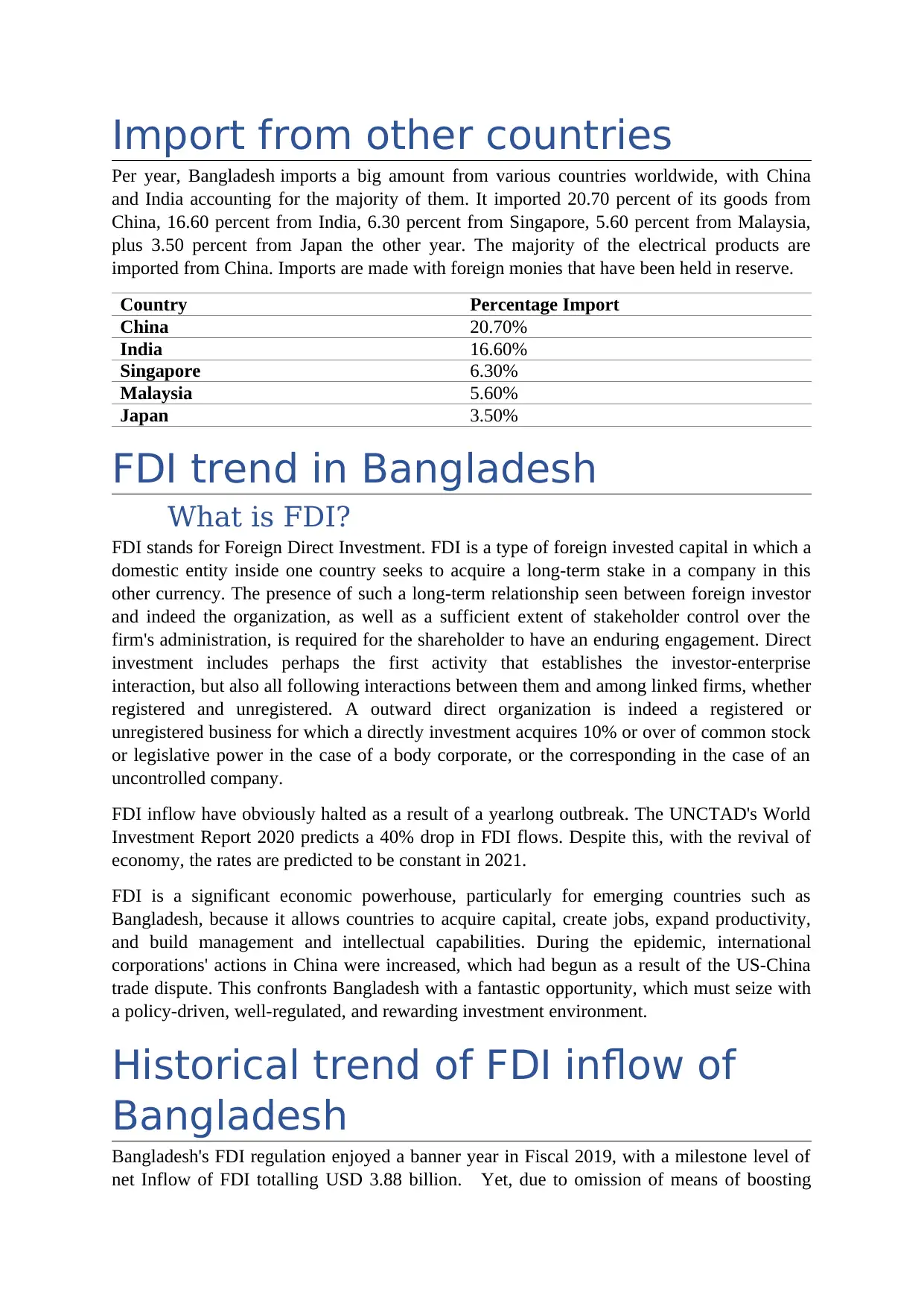
Import from other countries
Per year, Bangladesh imports a big amount from various countries worldwide, with China
and India accounting for the majority of them. It imported 20.70 percent of its goods from
China, 16.60 percent from India, 6.30 percent from Singapore, 5.60 percent from Malaysia,
plus 3.50 percent from Japan the other year. The majority of the electrical products are
imported from China. Imports are made with foreign monies that have been held in reserve.
Country Percentage Import
China 20.70%
India 16.60%
Singapore 6.30%
Malaysia 5.60%
Japan 3.50%
FDI trend in Bangladesh
What is FDI?
FDI stands for Foreign Direct Investment. FDI is a type of foreign invested capital in which a
domestic entity inside one country seeks to acquire a long-term stake in a company in this
other currency. The presence of such a long-term relationship seen between foreign investor
and indeed the organization, as well as a sufficient extent of stakeholder control over the
firm's administration, is required for the shareholder to have an enduring engagement. Direct
investment includes perhaps the first activity that establishes the investor-enterprise
interaction, but also all following interactions between them and among linked firms, whether
registered and unregistered. A outward direct organization is indeed a registered or
unregistered business for which a directly investment acquires 10% or over of common stock
or legislative power in the case of a body corporate, or the corresponding in the case of an
uncontrolled company.
FDI inflow have obviously halted as a result of a yearlong outbreak. The UNCTAD's World
Investment Report 2020 predicts a 40% drop in FDI flows. Despite this, with the revival of
economy, the rates are predicted to be constant in 2021.
FDI is a significant economic powerhouse, particularly for emerging countries such as
Bangladesh, because it allows countries to acquire capital, create jobs, expand productivity,
and build management and intellectual capabilities. During the epidemic, international
corporations' actions in China were increased, which had begun as a result of the US-China
trade dispute. This confronts Bangladesh with a fantastic opportunity, which must seize with
a policy-driven, well-regulated, and rewarding investment environment.
Historical trend of FDI inflow of
Bangladesh
Bangladesh's FDI regulation enjoyed a banner year in Fiscal 2019, with a milestone level of
net Inflow of FDI totalling USD 3.88 billion. Yet, due to omission of means of boosting
Per year, Bangladesh imports a big amount from various countries worldwide, with China
and India accounting for the majority of them. It imported 20.70 percent of its goods from
China, 16.60 percent from India, 6.30 percent from Singapore, 5.60 percent from Malaysia,
plus 3.50 percent from Japan the other year. The majority of the electrical products are
imported from China. Imports are made with foreign monies that have been held in reserve.
Country Percentage Import
China 20.70%
India 16.60%
Singapore 6.30%
Malaysia 5.60%
Japan 3.50%
FDI trend in Bangladesh
What is FDI?
FDI stands for Foreign Direct Investment. FDI is a type of foreign invested capital in which a
domestic entity inside one country seeks to acquire a long-term stake in a company in this
other currency. The presence of such a long-term relationship seen between foreign investor
and indeed the organization, as well as a sufficient extent of stakeholder control over the
firm's administration, is required for the shareholder to have an enduring engagement. Direct
investment includes perhaps the first activity that establishes the investor-enterprise
interaction, but also all following interactions between them and among linked firms, whether
registered and unregistered. A outward direct organization is indeed a registered or
unregistered business for which a directly investment acquires 10% or over of common stock
or legislative power in the case of a body corporate, or the corresponding in the case of an
uncontrolled company.
FDI inflow have obviously halted as a result of a yearlong outbreak. The UNCTAD's World
Investment Report 2020 predicts a 40% drop in FDI flows. Despite this, with the revival of
economy, the rates are predicted to be constant in 2021.
FDI is a significant economic powerhouse, particularly for emerging countries such as
Bangladesh, because it allows countries to acquire capital, create jobs, expand productivity,
and build management and intellectual capabilities. During the epidemic, international
corporations' actions in China were increased, which had begun as a result of the US-China
trade dispute. This confronts Bangladesh with a fantastic opportunity, which must seize with
a policy-driven, well-regulated, and rewarding investment environment.
Historical trend of FDI inflow of
Bangladesh
Bangladesh's FDI regulation enjoyed a banner year in Fiscal 2019, with a milestone level of
net Inflow of FDI totalling USD 3.88 billion. Yet, due to omission of means of boosting
⊘ This is a preview!⊘
Do you want full access?
Subscribe today to unlock all pages.

Trusted by 1+ million students worldwide
1 out of 23
Related Documents
Your All-in-One AI-Powered Toolkit for Academic Success.
+13062052269
info@desklib.com
Available 24*7 on WhatsApp / Email
![[object Object]](/_next/static/media/star-bottom.7253800d.svg)
Unlock your academic potential
Copyright © 2020–2025 A2Z Services. All Rights Reserved. Developed and managed by ZUCOL.





